2008 TOYOTA HIGHLANDER HYBRID engine overheat
[x] Cancel search: engine overheatPage 5 of 580
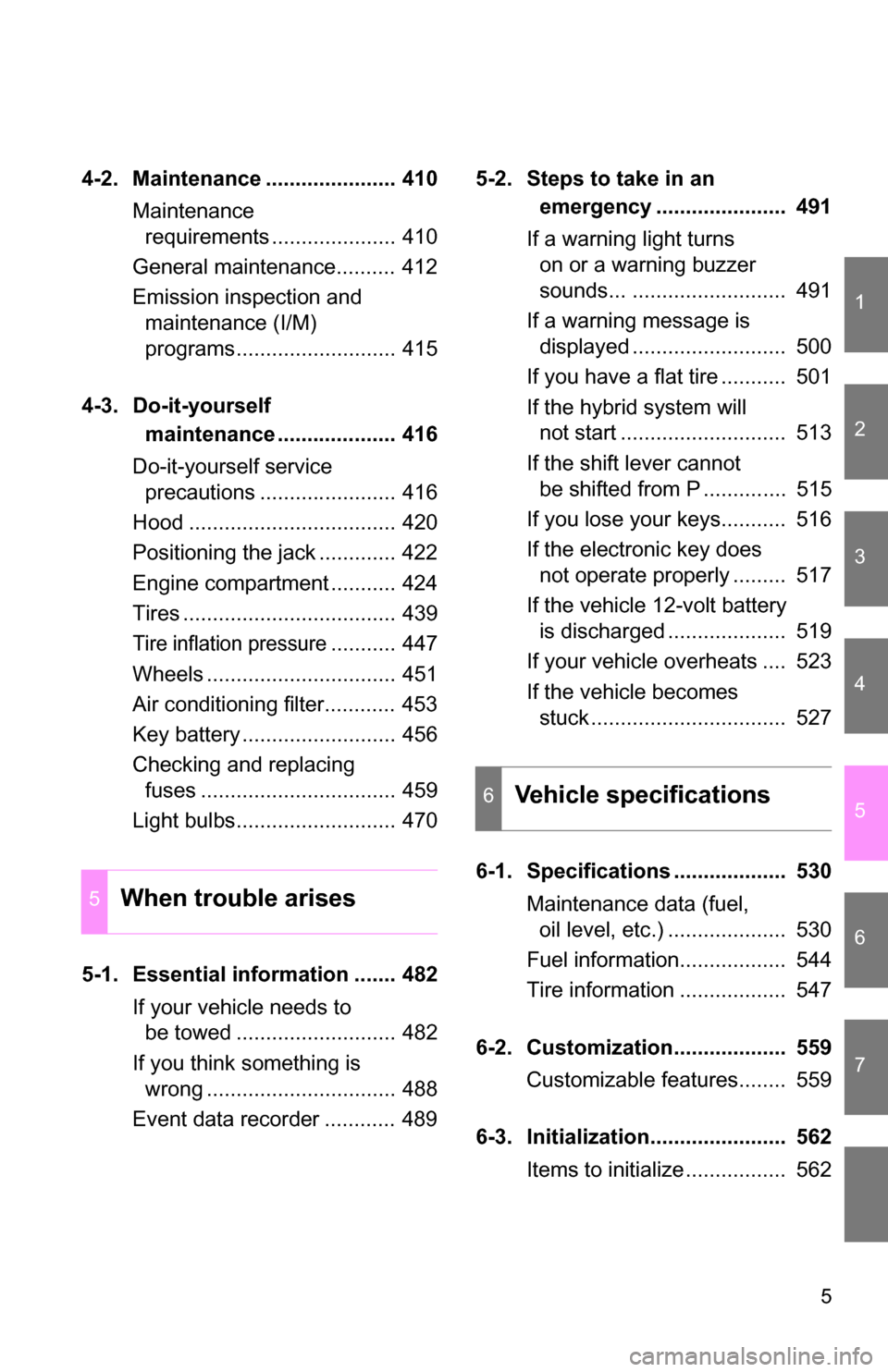
1
2
3
4
5
6
7
5
4-2. Maintenance ...................... 410Maintenance requirements ..................... 410
General maintenance.......... 412
Emission inspection and maintenance (I/M)
programs........................... 415
4-3. Do-it-yourself maintenance .................... 416
Do-it-yourself service precautions ....................... 416
Hood ................................... 420
Positioning the jack ............. 422
Engine compartment ........... 424
Tires .................................... 439
Tire inflation pressure........... 447
Wheels ................................ 451
Air conditioning filter............ 453
Key battery .......................... 456
Checking and replacing fuses ................................. 459
Light bulbs........................... 470
5-1. Essential information ....... 482 If your vehicle needs to be towed ........................... 482
If you think something is wrong ................................ 488
Event data recorder ............ 489 5-2. Steps to take in an
emergency ...................... 491
If a warning light turns on or a warning buzzer
sounds... .......................... 491
If a warning message is displayed .......................... 500
If you have a flat tire ........... 501
If the hybrid system will not start ............................ 513
If the shift lever cannot be shifted from P .............. 515
If you lose your keys........... 516
If the electronic key does not operate properly ......... 517
If the vehicle 12-volt battery is discharged .................... 519
If your vehicle overheats .... 523
If the vehicle becomes stuck ................................. 527
6-1. Specifications ................... 530 Maintenance data (fuel, oil level, etc.) .................... 530
Fuel information.................. 544
Tire information .................. 547
6-2. Customization................... 559 Customizable features........ 559
6-3. Initialization....................... 562 Items to initialize ................. 562
5When trouble arises
6Vehicle specifications
Page 169 of 580
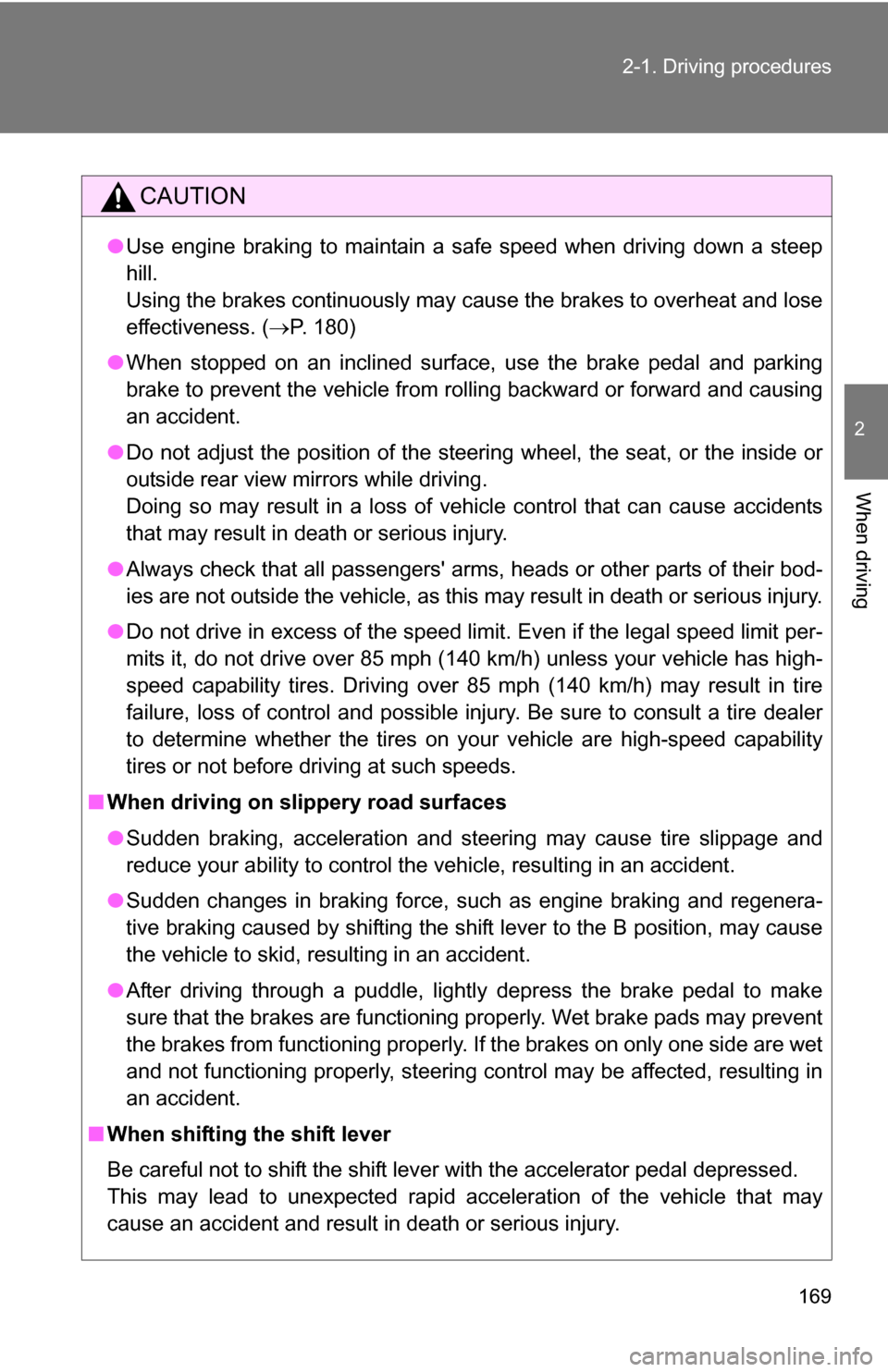
169
2-1. Driving procedures
2
When driving
CAUTION
●
Use engine braking to maintain a safe speed when driving down a steep
hill.
Using the brakes continuously may cause the brakes to overheat and lose
effectiveness. ( P. 180)
● When stopped on an inclined surface, use the brake pedal and parking
brake to prevent the vehicle from rolling backward or forward and causing
an accident.
● Do not adjust the position of the steering wheel, the seat, or the inside or
outside rear view mirrors while driving.
Doing so may result in a loss of vehicle control that can cause accidents
that may result in death or serious injury.
● Always check that all passengers' arms, heads or other parts of their bod-
ies are not outside the vehicle, as this may result in death or serious injury.
● Do not drive in excess of the speed limit. Even if the legal speed limit per-
mits it, do not drive over 85 mph (140 km/h) unless your vehicle has high-
speed capability tires. Driving over 85 mph (140 km/h) may result in tire
failure, loss of control and possible injury. Be sure to consult a tire dealer
to determine whether the tires on your vehicle are high-speed capability
tires or not before driving at such speeds.
■ When driving on slippery road surfaces
●Sudden braking, acceleration and steering may cause tire slippage and
reduce your ability to control the vehicle, resulting in an accident.
● Sudden changes in braking force, such as engine braking and regenera-
tive braking caused by shifting the shift lever to the B position, may cause
the vehicle to skid, resulting in an accident.
● After driving through a puddle, lightly depress the brake pedal to make
sure that the brakes are functioning properly. Wet brake pads may prevent
the brakes from functioning properly. If the brakes on only one side are wet
and not functioning properly, steering control may be affected, resulting in
an accident.
■ When shifting the shift lever
Be careful not to shift the shift lever with the accelerator pedal depressed.
This may lead to unexpected rapid acceleration of the vehicle that may
cause an accident and result in death or serious injury.
Page 185 of 580
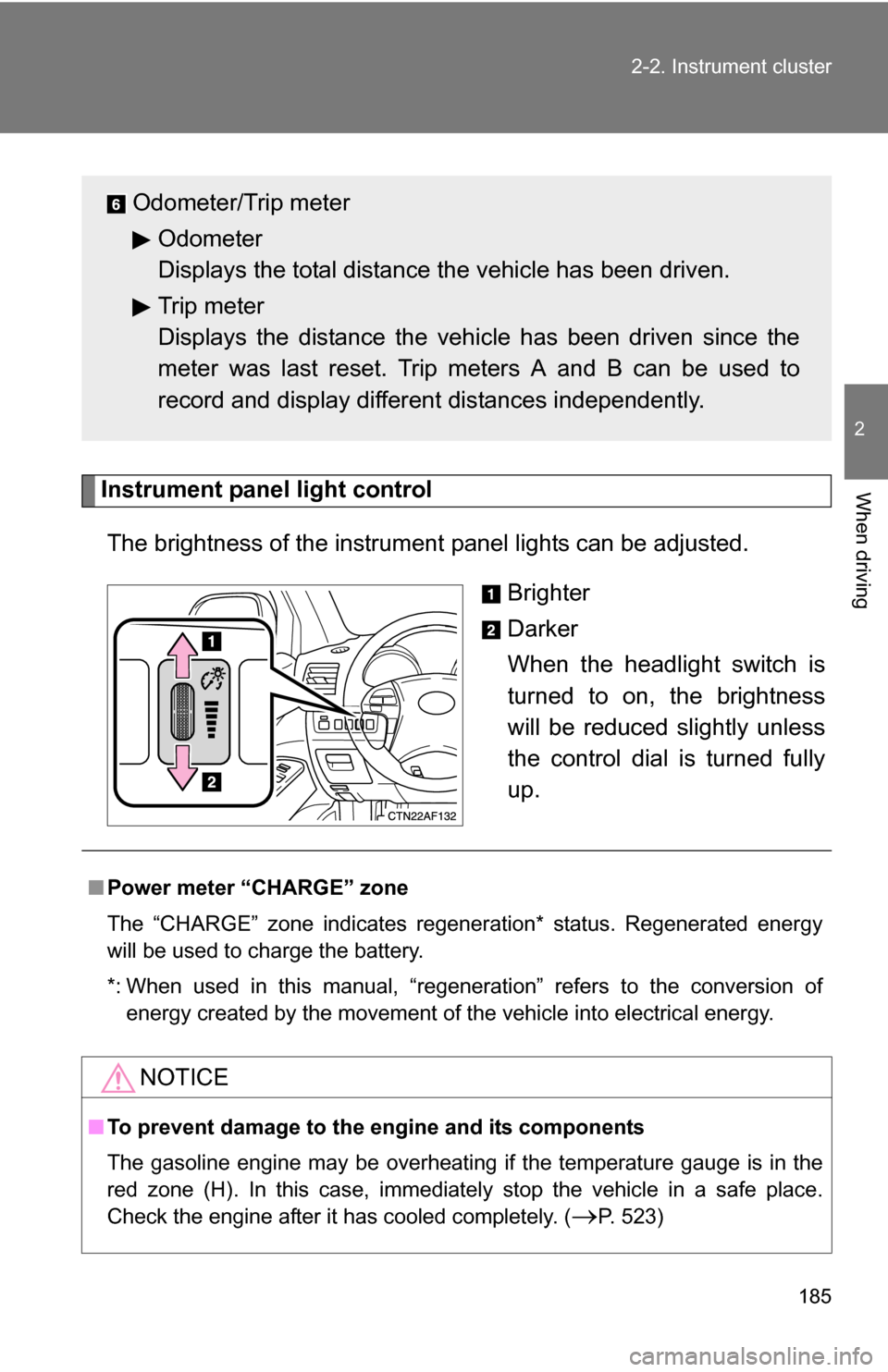
185
2-2. Instrument cluster
2
When drivingInstrument panel light control
The brightness of the instrument panel lights can be adjusted.
Brighter
Darker
When the headlight switch is
turned to on, the brightness
will be reduced slightly unless
the control dial is turned fully
up.
Odometer/Trip meterOdometer
Displays the total distance the vehicle has been driven.
Trip meter
Displays the distance the vehi cle has been driven since the
meter was last reset. Trip meters A and B can be used to
record and display different distances independently.
■ Power meter “CHARGE” zone
The “CHARGE” zone indicates regeneration* status. Regenerated energy
will be used to charge the battery.
*: When used in this manual, “regeneration” refers to the conversion of
energy created by the movement of the vehicle into electrical energy.
NOTICE
■To prevent damage to the engine and its components
The gasoline engine may be overheating if the temperature gauge is in the
red zone (H). In this case, immediately stop the vehicle in a safe place.
Check the engine after it has cooled completely. (
P. 523)
Page 239 of 580
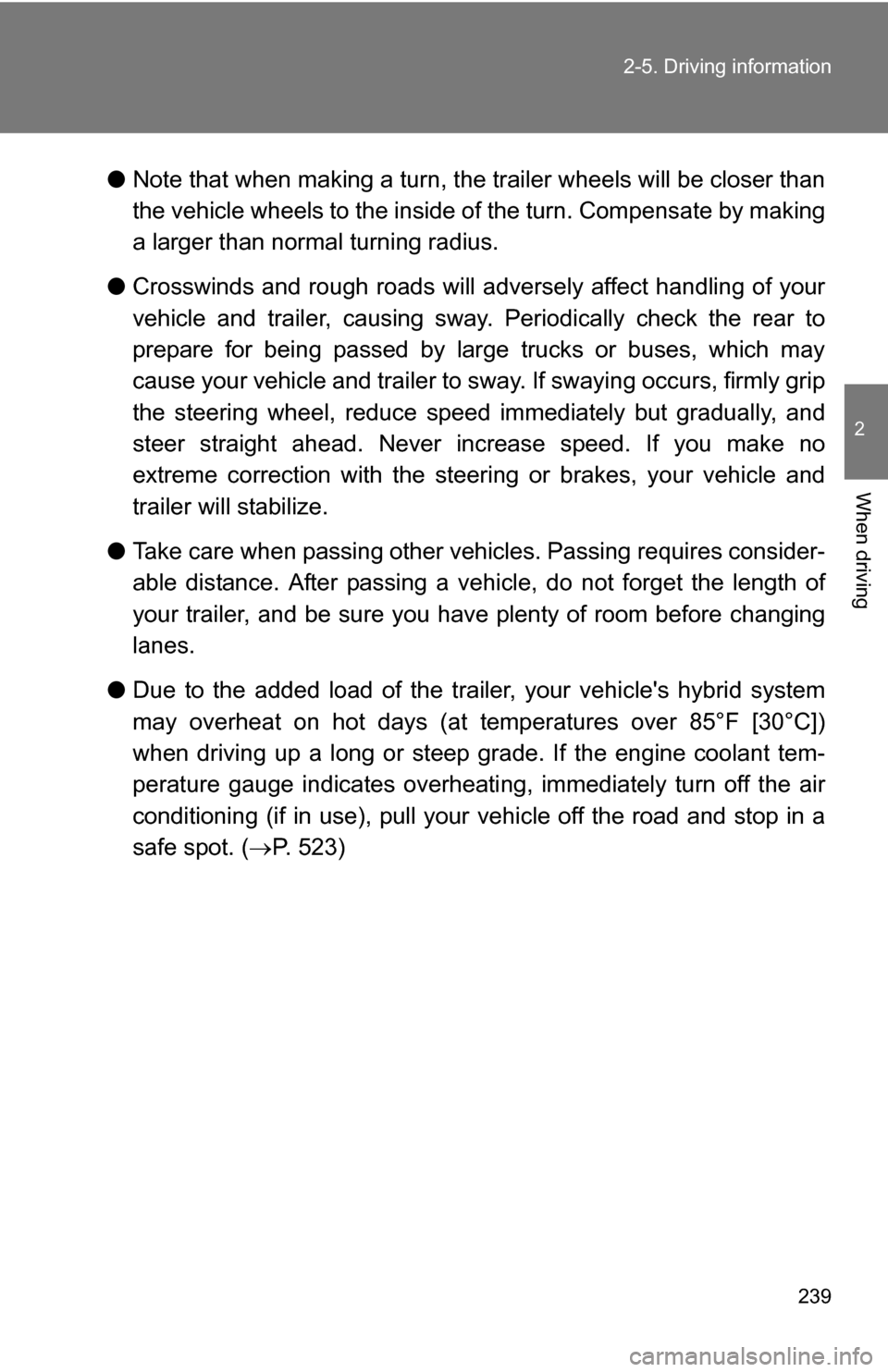
239
2-5. Driving information
2
When driving
●
Note that when making a turn, th e trailer wheels will be closer than
the vehicle wheels to the inside of the turn. Compensate by making
a larger than normal turning radius.
● Crosswinds and rough roads will adversely affect handling of your
vehicle and trailer, causing sway . Periodically check the rear to
prepare for being passed by large trucks or buses, which may
cause your vehicle and trailer to sway. If swaying occurs, firmly grip
the steering wheel, reduce speed immediately but gradually, and
steer straight ahead. Never increase speed. If you make no
extreme correction with the stee ring or brakes, your vehicle and
trailer will stabilize.
● Take care when passing other vehicles. Passing requires consider-
able distance. After passing a vehicle, do not forget the length of
your trailer, and be sure you hav e plenty of room before changing
lanes.
● Due to the added load of the trailer, your vehicle's hybrid system
may overheat on hot days (at temperatures over 85°F [30°C])
when driving up a long or steep grade. If the engine coolant tem-
perature gauge indicates overheati ng, immediately turn off the air
conditioning (if in use), pull your vehicle off the road and stop in a
safe spot. ( P. 523)
Page 523 of 580
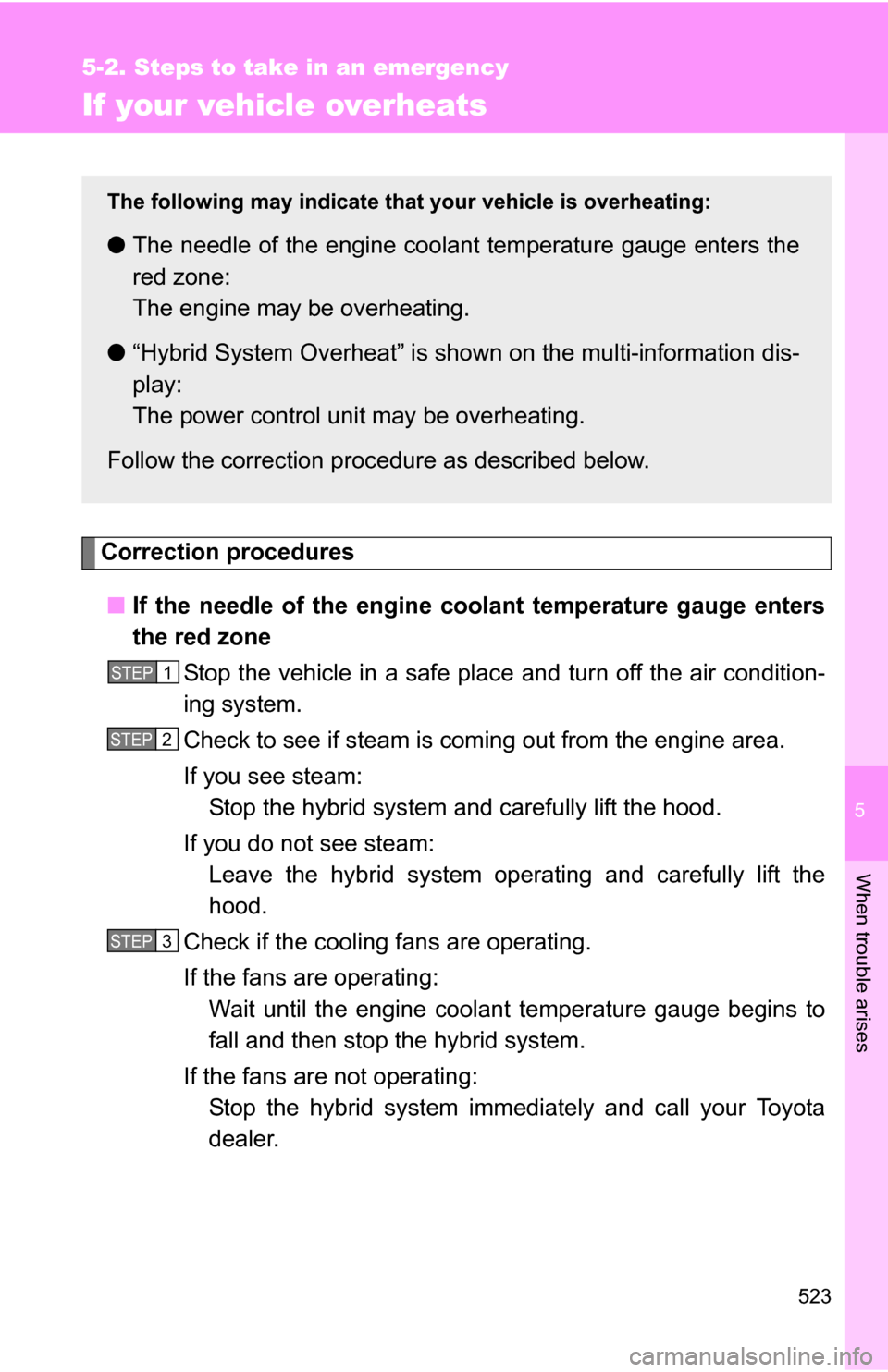
5
When trouble arises
523
5-2. Steps to take in an emergency
If your vehicle overheats
Correction procedures■ If the needle of the engine coolant temperature gauge enters
the red zone
Stop the vehicle in a safe place and turn off the air condition-
ing system.
Check to see if steam is coming out from the engine area.
If you see steam:
Stop the hybrid system and carefully lift the hood.
If you do not see steam: Leave the hybrid system operating and carefully lift the
hood.
Check if the cooling fans are operating.
If the fans are operating: Wait until the engine coolant temperature gauge begins to
fall and then stop the hybrid system.
If the fans are not operating: Stop the hybrid system immediately and call your Toyota
dealer.
The following may indicate that your vehicle is overheating:
●The needle of the engine coolant temperature gauge enters the
red zone:
The engine may be overheating.
● “Hybrid System Overheat” is shown on the multi-information dis-
play:
The power control unit may be overheating.
Follow the correction procedure as described below.
STEP1
STEP2
STEP3
Page 526 of 580
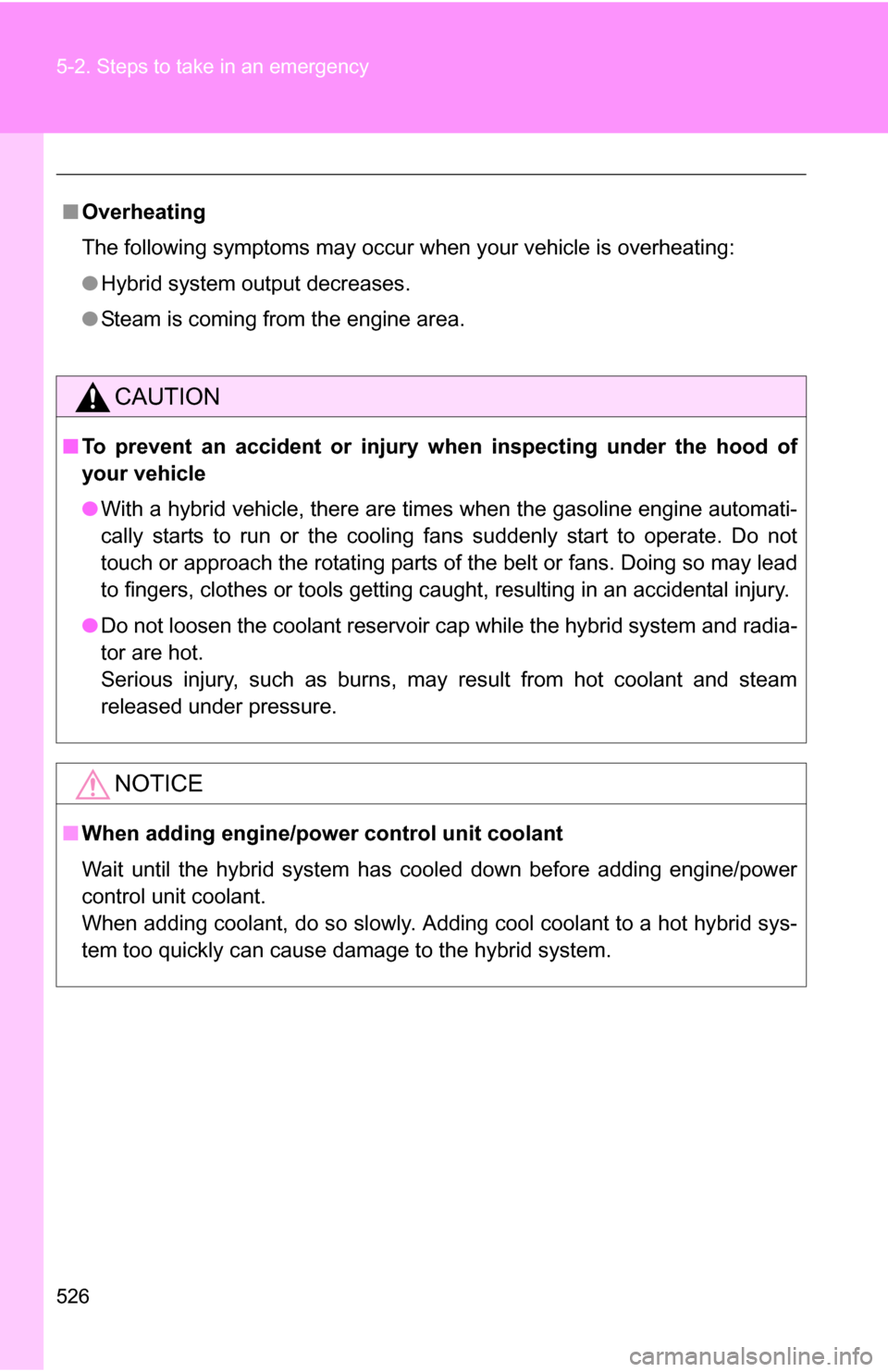
526 5-2. Steps to take in an emergency
■Overheating
The following symptoms may occur when your vehicle is overheating:
●Hybrid system output decreases.
● Steam is coming from the engine area.
CAUTION
■To prevent an accident or injury when inspecting under the hood of
your vehicle
● With a hybrid vehicle, there are times when the gasoline engine automati-
cally starts to run or the cooling fans suddenly start to operate. Do not
touch or approach the rotating parts of the belt or fans. Doing so may lead
to fingers, clothes or tools getting caught, resulting in an accidental injury.
● Do not loosen the coolant reservoir cap while the hybrid system and radia-
tor are hot.
Serious injury, such as burns, may result from hot coolant and steam
released under pressure.
NOTICE
■When adding engine/power control unit coolant
Wait until the hybrid system has cooled down before adding engine/power
control unit coolant.
When adding coolant, do so slowly. Adding cool coolant to a hot hybrid sys-
tem too quickly can cause damage to the hybrid system.
Page 570 of 580
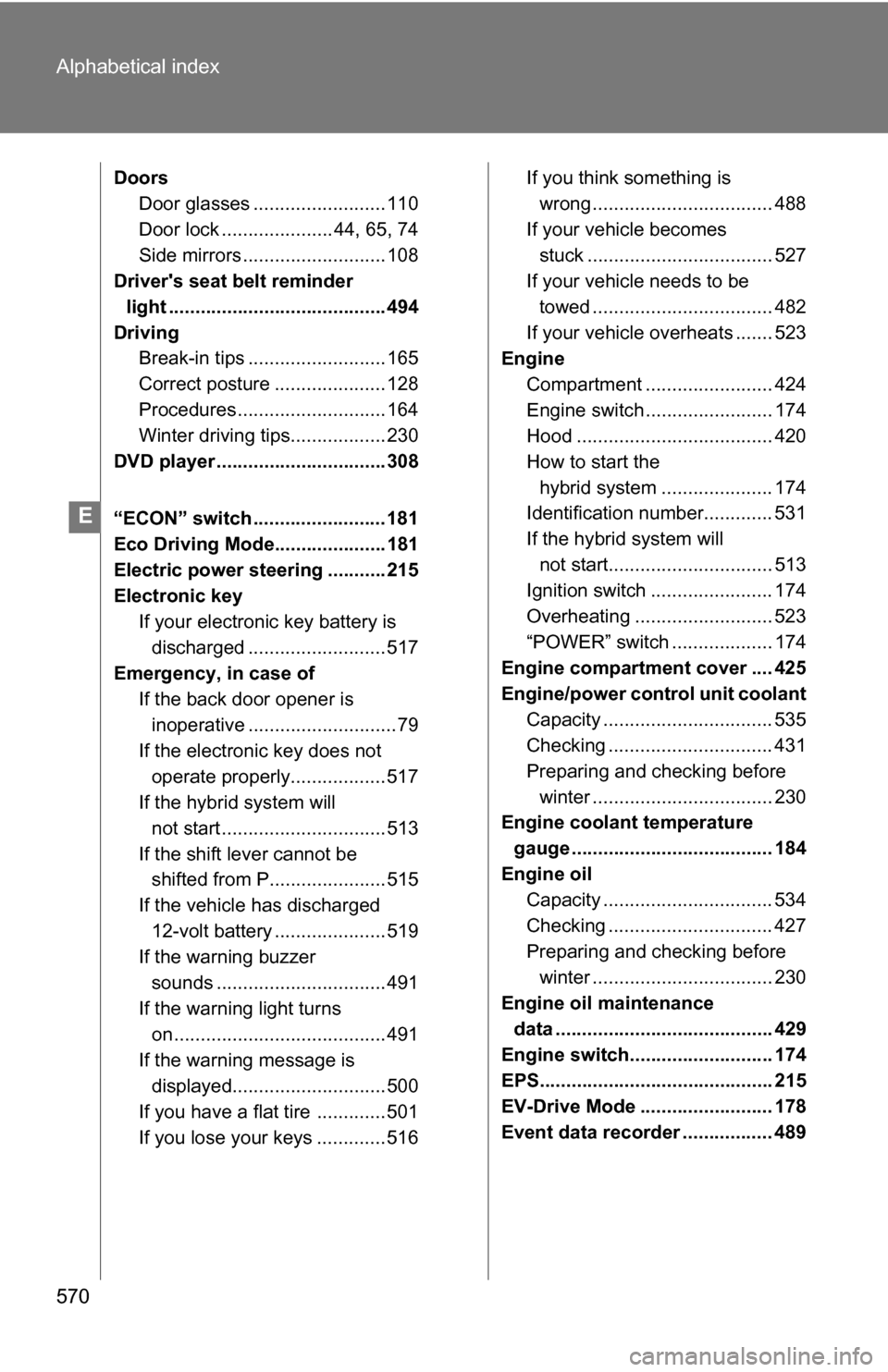
570 Alphabetical index
DoorsDoor glasses ......................... 110
Door lock ..................... 44, 65, 74
Side mirrors ........................... 108
Driver's seat belt reminder
light ......................................... 494
Driving Break-in tips .......................... 165
Correct posture ..................... 128
Procedures ............................ 164
Winter driving tips.................. 230
DVD player ................................ 308
“ECON” switch ......................... 181
Eco Driving Mode..................... 181
Electric power steering ........... 215
Electronic key If your electronic key battery is discharged .......................... 517
Emergency, in case of If the back door opener is inoperative ............................79
If the electronic key does not operate properly.................. 517
If the hybrid system will
not start ............................... 513
If the shift lever cannot be shifted from P...................... 515
If the vehicle has discharged 12-volt battery ..................... 519
If the warning buzzer
sounds ................................ 491
If the warning light turns on ........................................ 491
If the warning message is displayed............................. 500
If you have a flat tire ............. 501
If you lose your keys ............. 516 If you think something is
wrong .................................. 488
If your vehicle becomes stuck ................................... 527
If your vehicle needs to be
towed .................................. 482
If your vehicle overheats ....... 523
Engine
Compartment ........................ 424
Engine switch ........................ 174
Hood ..................................... 420
How to start the hybrid system ..................... 174
Identification number............. 531
If the hybrid system will
not start............................... 513
Ignition switch ....................... 174
Overheating .......................... 523
“POWER” switch ................... 174
Engine compartment cover .... 425
Engine/power control unit coolant
Capacity ................................ 535
Checking ............................... 431
Preparing and checking before winter .................................. 230
Engine coolan t temperature
gauge ...................................... 184
Engine oil Capacity ................................ 534
Checking ............................... 427
Preparing and checking before winter .................................. 230
Engine oil maintenance data ......................................... 429
Engine switch........................... 174
EPS............................................ 215
EV-Drive Mode ......................... 178
Event data recorder ................. 489
E
Page 572 of 580

572 Alphabetical index
Interior lightsInterior lights.......................... 361
Switch............................ 362, 363
Wattage ................................. 543
Jack Positioning the jack ............... 422
Replacing the wheel .............. 501
Jack handle .............................. 501
Keyless entry..............................65
Keys Electronic key ..........................42
Engine switch ........................ 174
If the electronic key does not operate properly.................. 517
If you lose your keys ............. 516
Ignition switch........................ 174
Keyless entry...........................65
Key number .............................42
Keys ........................................42
Mechanical key .......................42
“POWER” .............................. 174
Wireless remote control key ........................................65
License plate lights Replacing light bulbs ............. 470
Wattage ................................. 543
Light bulbs Replacing .............................. 470
Wattage ................................. 543
Lights Door courtesy lights .............. 361
Fog light switch ..................... 204
Headlight switch .................... 200
Interior light switch ........362, 363
Outer foot lights ..................... 361
Personal light switch ............. 362
Replacing light bulbs ............. 470
Turn signal lever.................... 182 Vanity lights........................... 379
Wattage................................. 543
Load capacity ........................... 229
Lock steering column.............. 176
Luggage cover ......................... 390
Maintenance Do-it-yourself maintenance ....................... 416
General maintenance............ 412
Maintenance data ................. 530
Maintenance requirements ... 410
Meter
Instrument panel light control ................................. 185
Meters ................................... 184
Mirrors Conversation mirror .............. 380
Inside rear view mirror .......... 106
Side mirror heaters ............... 267
Side mirrors........................... 108
Vanity mirrors ........................ 379
Moon roof ................................. 112
MP3 disc ................................... 287
Multi-information display .................................... 190
Off-road precautions ............... 220
Odometer .................................. 184
Oil Engine oil .............................. 427
Opener Back door ................................ 77
Fuel filler door ....................... 115
Glass hatch ............................. 82
Hood ..................................... 420
Outside rear view mirrors Adjusting and folding............. 108
Outside temperature
display .................................... 190
Overhead console.................... 366
Overheating, Hybr id system ... 523
J
K
L
M
O